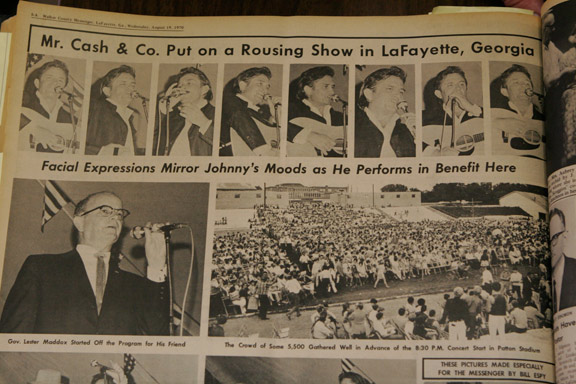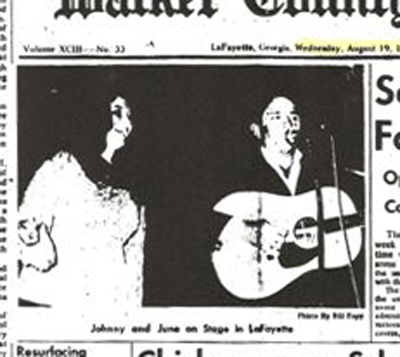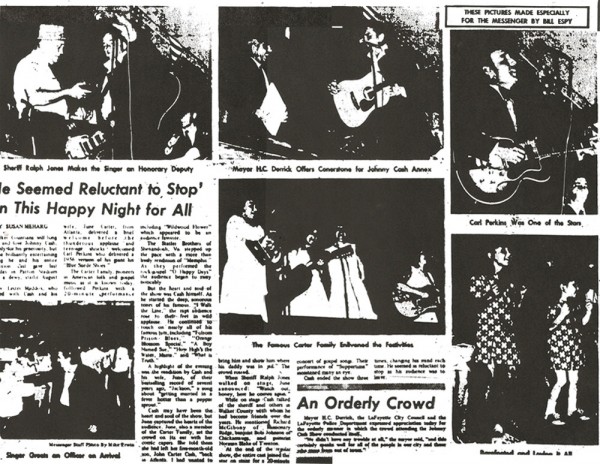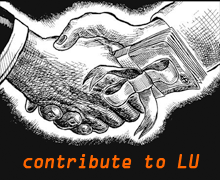08.24
|
|
As advertised, the show began at 8:30 PM on August 13th.
After a brief speech from Governor Lester Maddox, Carl Perkins took the stage and delivered a performance of “Blue Suede Shoes.” Perkins was followed by a 20-minute set from the Carter Family, then a performance from the Statler brothers. The rest of the show was nearly all Cash. |
Mr. Cash began with his most popular song, “I Walk the Line,” and moved on to perform most of his standard late-1960’s live concert repertoire – including “Orange Blossom Special,” “What is Truth,” “A Boy Named Sue,” “Jackson” with wife June Carter, and “Folsom Prison Blues.”
No audio recording of the LaFayette show is known to exist, but it closely mirrored Cash’s infamous Folsom Prison concerts held almost three years earlier. A live album recorded from those shows, “At Folsom Prison,” is highly recommended for anyone with a slight interest in pre-1990’s Cash music or the LaFayette concert. (The remains of Patton Stadium are a good place to listen to it, at least until bulldozing begins.)

A score of politicians from across Georgia came to the show, including governor Lester Maddox. The contents of Maddox’s speech aren’t available, but he (like almost everyone else in leadership at the time) claimed to be a close personal friend of all the performers. Maddox, Georgia Governor from 1967 until 1971, is best known for his segregationist views and for threatening to beat negroes with axe handles if they tried to eat in his Atlanta restaurant.
Also at the concert was 46-year-old Georgia State Senator Jimmy Carter, who was busy campaigning to take over Maddox’s job. He won the governor’s race that November, served as Georgia’s chief executive from 1971 to 1975, then became 39th President of the United States in 1977. His presidency was considered (at best) unproductive and he’s best known now for diplomatic service and volunteer work done after retirement.
Despite hailing from the same state and same political party, Maddox and Carter were politically opposite in almost every way. Maddox clung to segregation and ways of the past, appealing mostly to older voters; Carter publicly supported the Civil Rights Movement and came across as a progressive who appealed to the young. Both men were physically present in LaFayette at the same time on August 13, 1970, and the ideals of both were well represented among the crowd gathered for the Cash concert. Cash himself stood in a rare space of appealing to both sides; a man with a criminal reputation who had turned his life over to God, appreciated by older voters for his values and liked by younger voters for his honesty and understanding.
Local politicians also made their presences known. Sheriff Ralph Jones took the stage after Cash finished performing to present a plaque and Sheriff’s badge, making the singer an honorary Walker County Sheriff’s Deputy. Mayor Derrick then presented Cash with the Activity Complex’s ceremonial cornerstone.
Outside of one incident with an Atlanta “nightclub dancer” trying to take the stage, the crowd was well-behaved and LaFayette’s Cash concert ran smoothly. The musicians seemed to enjoy themselves, and all who were fortunate enough to be in Patton Stadium on that muggy night in 1970 had a wonderful time during the show.
Most at the LaFayette Cash Show probably realized that it was a once-in-a-lifetime event, but none could foresee it as the city’s peak before beginning a slow, painful decline. No community stays the same forever, but many changes in LaFayette over the last forty years haven’t been for the better. Today the city has lost its economic strength, good leaders, political importance, and a social fabric – leaving behind a town that few from 1970 would recognize.
All is not lost – the decline can be reversed. LaFayette can never be exactly the same as it was 41 years ago, but it can be a better place than it is today. Cash often sang and spoke about having concern for fellow man, about loving neighbors and looking out for the “poor and beaten-down.” Taking that message to heart would be a great step towards renewing the city. A lack of leadership (both elected or otherwise) willing to put the interests of others ahead of their own is one of the main reasons for LaFayette’s current condition.
A better LaFayette can be built here – but we must have love and vision to make that happen. We must step up to do the hard work, taking responsibility to create a future as strong as the past. That’s truly the best way to honor Cash and the late leaders who managed, at least on one night 41 years ago, to make LaFayette the center of positive attention and excitement.













If you’re reading this comment without checking out all six pages of the blog post, go read them. This is the first article in LU’s two year history that was long enough to require multiple pages. I hope that makes it easier to read. If the format or navigation give you any trouble please let us know.
Now, to clarify and explain a few things about the article…
We had originally hoped to get this done LAST year on the concert’s 40th anniversary, but due to other pressing issues and some research problems it wasn’t possible in 2010. We did get something up last year ( http://www.cityoflafayettega.com/2010/08/the-man-in-black/) but not the article originally planned. This year’s piece wasn’t done on August 13th either, but close enough to post. Apologies for not having it finished on time, this site is a bit of a side job for some of us and other things have to take priority.
Most of the research problems we had were due to a total lack of cooperation at the Walker County Messenger office. A now-former employee of the WCM assured us that their archives were available by request, with over 100 years of old papers in a filing cabinet easily accessible in their office. But when we sent a researcher to their office another employee there was anything but helpful. Our poor volunteer was given a runaround, treated hatefully, and told that the papers we wanted were “in the old building” and inaccessible.
The researcher finally resorted to using the LaFayette library where employees were both friendly and helpful. They found a folder of printouts from microfiche archives of the Messenger and got copies of those to scan. Those scanned copied printouts are the black and white images used in this article. Unfortunately they were originally archived in a format that doesn’t retain gray tones, which is why the photos look so terrible. If you have any better versions of the images used please let us know and we’ll gladly replace them. Also feel free to add information (or corrections) about the events and people mentioned.
Color newspaper images (and some facts) included came from last January’s Messenger article about the city’s stadium renovation plans – http://www.catwalkchatt.com/view/full_story/11045408/article-Renovation-plans-for-old-LaFayette-High-stadium-has-people-remembering-Cash-benefit-from-1970? . Those inaccessible archives apparently became accessible again when it was for their own purposes (which is fair, it’s their own stuff) – but that article wouldn’t have surfaced either, without our original article last June reminding people that the football field still exists and has been neglected.
Thanks to researcher VS for all the hard work in tracking down the archived documents and putting up with harassment from people who should have better manners.
— LU
I am really glad that you guys decided to make this post this year, it was VERY well written and explained a lot about a piece of La Fayette history I have been very interested in for some time, but could never find much information about myself. I sincerely hope that the city does take steps towards fixing up this stadium, and it saddens me that it took them this long to see the fact that this stadium could be so useful. I booked concerts through the Recreation Center in the building right above the field and every time I would walk outside and look at the field and wish that I could have the concerts out there and set up some other events that aren’t centered around just one group of people. If they begin to take volunteers to help do the work though, I will most definitely sign up, and get as many people I know to do so also. We need to work together to better this community if we are to make any progress. Thank you LU, and keep doing what you’re doing!